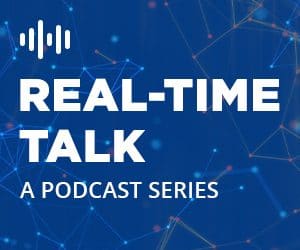
RTInsights editors Joe McKendrick, Jim Connolly, Lisa Damast, and Sal Salamone discuss continuous intelligence (CI). What is it? Why is it getting so much attention now?
In this RTInsights Real-Time Talk podcast, RTInsights editors Joe McKendrick, Jim Connolly, Lisa Damast, and Sal Salamone discuss continuous intelligence (CI). What is it? Why is it getting so much attention now? What are its benefits and applications? And who in an organization should be driving its use? This episode is the first in a new series called Understanding Continuous Intelligence that is sponsored by Sumo Logic and will feature discussions with industry experts to explore continuous intelligence in the enterprise.
See Also: Continuous Intelligence Insights
Listen to the podcast now:
Subscribe to Real-Time Talk on your favorite platform:
About the Continuous Intelligence Insights Center:
From real-time fraud prevention to enhanced customer experience to dynamic energy load balancing, businesses of all types and sizes are realizing the benefits of Continuous Intelligence, helping them make decisions in real-time while events are happening.
Where do you begin, though?
What are the key requirements?
RTInsights’ Continuous Intelligence Insights center, sponsored by Sumo Logic, brings together the latest insights and advice on continuous intelligence to answer these questions and more.
Read the transcript:
Joe: Hello, and welcome to the first episode of understanding continuous intelligence on RT Insights real-time talk podcast in partnership with Sumo logic. I’m Joe McKendrick, industry analyst at RTInsights and your host for today’s discussion about continuous intelligence. Joining me today are Lisa Damast, head of marketing and writer with RTInsights; Jim Connolly, a journalist with RTInsights; and south Sal Salamone, Editor-in-Chief of our RTInsights. Welcome, everybody. And we’re looking forward to a great chat. And today, we want to talk about what we’re launching this wonderful podcast series, and we want to talk about the types of topics and areas we’re going to explore. Okay. Let’s get started. Let’s find what we mean by continuous intelligence. That’s a term, intelligence, in general, is a term that gets thrown a lot around a lot in the IT world.
Featured Resource: Continuous Intelligence and the Era of Real-Time, Data-Driven Business [Download Now]
Of course, now we have artificial intelligence and augmented intelligence and all that good stuff. I’m going to start with Gartner, how the way Gartner defines continuous intelligence. And, and let me know if you want to build on that. Gardner says continuous intelligence is a design pattern in which real-time analytics are integrated into business operations, processing, current and historical data to prescribe actions in response to business moments and other events. In other words, it’s very event-driven. Folks, do you want to build on that definition, as we’re going to be exploring it in this podcast series.
Jim: I think one of the things that I would add to that is that continuous intelligence really is an extension of what we’ve been seeing in IT and business sectors over the past few years with the evolution of, of AI and things like AIOps.
Joe: AIOps and machine learning, those are things that really are bringing continuous intelligence to the forefront, making continuous intelligence a viable business strategy. Am I right?
Jim: Yes.
Sal: I’d say one thing that is different with continuous intelligence is that today there are so many sources of information that are being used either in a business process or in operations team or whatever, a security team that is sorting through it. It’s no longer enough just to get alerts. You need to be able to intelligently integrate the information from very many disparate sources, get some insights from all of that information that’s being blasted at you, and then make a decision based on that all in real time, in seconds or sub-seconds.
Joe: How far along are our companies with continuous intelligence? Is this something that everybody’s just starting to explore a pilot proof of concept? Are there they’re working use cases out there? In other words, is it now out in the business world? Is it viable? Is it scaling, or is this something that’s still in the proofs of concept stage?
Jim: I would say it’s been most heavily used in some of the big tech companies, Google, Facebook, Microsoft, and companies like that are just starting to show up in enterprise organizations that are selling consumer products and things like that in more in pilot stages or single business unit type cases, as opposed to being, rolled out across an entire enterprise and handling all the applications.
Sal: And there are some specific areas where it’s being applied, for example, security operations is one and modernizing that because there’s so much risk, so much danger and need for quick action, you need to be very proactive. So that’s one, application modernization is another, there are all these companies doing their digital transformations. They need to find these hidden dependencies that are causing problems, impacting the user experience, slowing down things that are going on within their organization.

Joe: I’m wondering how this kind of dovetail together with cloud. Everybody’s moving to cloud these days. You see the cloud services AWS and Google cloud platform. We have a lot of processing power, a lot of capabilities now available out in the cloud. This is really helping propel this ability to deliver continuous intelligence.
Jim: The cloud is playing a key role in that it enables continuous intelligence. It supports it in terms of where the CI applications are, are housed. But also, the cloud is crucial because CI helps you manage the cloud, particularly the multi-cloud type situation.
Sal: Yes. And I think one of the reasons we’re doing this podcast and working with companies like Sumo Logic is that it’s an emerging field. I mean, continuous intelligence has been around before, but its application is now very broad across not just business processes but operational technology. I think one of the drivers for our work at RTInsights is trying to educate the market, present some use cases, things like that. I think that ties back into what the purpose of this hub that we’re working on.
Lisa: The three of you touched upon the areas of backend adoption of continuous intelligence is accelerating with the rise of real-time data and analytics. These trends around cloud and Sal had mentioned, the number of use cases are multiplying, and we’re seeing executives from the C-suite and anything from a CIO is that it was down to data scientists and line of business managers who are asking a variety of questions to better understand thinking about intelligence, including how do I get started and what are the key requirements. And so, with the hub, we’ve partnered with Sumo logic, which is a leader in continuous intelligence, to bring the latest insights and advice on continuous intelligence to answer these questions and more.
Joe: Okay, great, great, fantastic. Along those lines, who should be getting involved with continuous intelligence in the organization? You mentioned the executives and the higher-level executives need to understand it. Who should lead the way, for example, with continuous intelligence, who’s in a position in the organization, to lead the charge, if you will?
Jim: The CIO is probably best positioned to lead the way along with some of the direct reports, such as the directors of different IT functions. But the real leader, in the end, has to be the CEO and the board. That’s going to say, let’s go ahead with this because we need it. We need this insight, and we need this ability to respond in real time.
Sal: It has applications across the whole enterprise. It could be very many different departments and functional areas. It could be a security analyst. It could be a DevOps engineer. It could be a compliance manager or an IT ops manager that needs the information that that CI provides. You don’t want each one of them choosing their own solution. It’s better to have, as Jim was mentioning from the top down, have a solution, an approach to using CI that can be adapted to anyone in the organization.
Jim: Right. It extends beyond IT as well. Because you are talking about things like there’s one use case out there for retail pricing on a seasonal basis and the variations. The sales and marketing person may be the driving force there. They are saying we need this capability to address our prices online or in a brick-and-mortar store, basically at the drop of a hat.
Joe: So, it’s something that everybody in the enterprise needs to get involved with. Hopefully, with this podcast, we’re going to be, reaching out to not only the technical folks, the folks that are already working with real-time solutions but also CIOs and the people in the C-suite people organizing the business to function better with continuous intelligence.
Sal: Stay tuned for more, I guess, stay tuned…
Joe: Stay tuned for more. Again, this is the launch of a series. We’re going to be talking with a lot of experts in the industry. We had three great people here today with us, Lisa Damast, Jim Connelly, and Sal Salamone, to kind of kick things off great discussion folks. We look forward to exploring more as we move forward with this.
Featured Resource: Continuous Intelligence and the Era of Real-Time, Data-Driven Business [Download Now]






